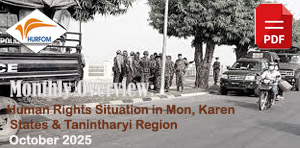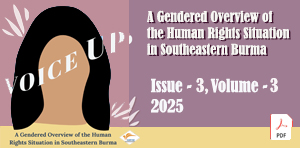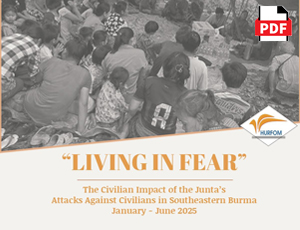June 24, 2015
An issue we must not leave behind
Burma is a patriarchal society where, despite Aung San Suu Kyi’s high profile, gender inequality still exists. Women are still denied equal rights and continue to face discrimination. Politics is one key realm where Burma’s ongoing gender inequality comes into focus. Read more
Destroyed and Abandoned
March 5, 2015
Civilian land confiscated by the military and government departments for State projects and private companies has reached 2 million acres. The majority of confiscated lands are owned by small-holder farmers, with 90% of the victims dependent solely on their lands for their livelihoods. With such devastating effects on rural livelihoods, land conflict is the most pressing issue facing Burma today, second only to armed conflict. Read more
What Defines a Good Leader?
January 14, 2015
In Burma’s 2010 general election, the country’s first election in twenty years, former military commander U Thein Sein won a majority vote to become the president of Burma. For five years now, since that election, Burma has been transitioning towards democracy. In the upcoming 2015 presidential elections, the election commission has committed, to both the people of Burma and world leaders, to hold free and fair elections. Read more
Burmese Government Fails to Protect its Women and Children from Sexual Violence
February 28, 2014
Sexual violence and abuse committed by the Burmese military against ethnic women is a constant and ongoing danger for the women of Burma. On January 27, 2014, a soldier from Artillery Battalion No 315, based in Wae Ka Lee, assaulted and beat a local woman. According to a local source, the victim was brought to Rangoon hospital on February 4 to further treat a serious head injury bore during the attack. Although the Burmese government has signed United Nations Conventions to ensure the protection of women and children, the government is failing provide, and in many cases obstructing, such protection. Read more
Sex-Work Industry Rising in our Cities; Government Must Address This Issue
January 30, 2014
WCRP: Ma Eli Htwe , 20 year-old, is from YaeLalKout Tan, in Rangon. She is working in a massage bar in Own Pinn village, which lies along a gas pipeline that is longer, but less well-known, than the controversial Yadana pipeline that it connects to. Today, Ohn Pin Kwin is predominantly home to ethnic Tavoy people, with a small Mon population. Read more
Spotlight on Poverty and Child Labor in Burma
January 22, 2014
HURFOM: It’s 5:00am, and the early morning fog makes the sky look very dark; a limousine from Ta La Mon arrives at the bus station in Myay Nee Gon, Moulmein, Mon State. It’s time for the local children to start their daily search for plastic, which they redeem to buy food for themselves and their families. Read more
Beyond the male: The case for a gender analysis of illicit drugs in Burma
July 19, 2013
WCRP: On June 26, Burma’s anti-narcotics task force marked the International Day Against Drug Abuse and Illicit Trafficking by destroying over 4.4 billion kyat worth of illegal drugs. This move, along with others aimed at rehabilitating drug users and developing alternative crops for poppy farmers, seems fitting in light of recent international recognition of the country’s drug problems. In the past year Burma has been named by the United Nations Office on Drugs and Crime (UNODC) as the world’s second largest producer of opium and the “top source of illicit methamphetamine pills in East and Southeast Asia.” Read more
Education reform remains elusive
July 19, 2013
WCRP: In March 2011, President U Thein Sein gave a speech to parliament urging improvements to the national education system. He called for implementing a system of free, compulsory primary schooling, upgrading the country’s educational standards to international levels, and increasing enrollment in basic education. Changes have thereby been made in the last few years that ostensibly liberated students and their families to freely pursue education. According to education officials, registration fees have been waived, textbooks are provided free of charge, and the local administrators’ practice of collecting “donations” to buy school equipment (for everything from the headmaster’s chair to a football for the schoolyard) was targeted for elimination. Read more
Young People and Drugs
May 8, 2013
Introduction
Civil society groups discussed the issue of drug use in a development seminar for Mon people, in order to write a paper about drugs based on as much information from the community as possible. These civil society groups think that young people, as our future leaders, need to take responsibility for their country’s political situation. However, there is a currently a serious drug problem in Mon areas, which gives us cause for concern about young Mon people today and their ability to take on this role. The authors of this paper have researched this topic and written this paper as part of their aim to eradicate drug use in Mon State.
The history of drugs in Mon State
50 years ago people living in Mon State could not buy bottled alcohol. Instead Mon people cooked sugar cane together with another ingredient to turn this into alcohol, making what is called “Ha Jo”. Ha Jo was often given out to guests at parties and social gatherings. In this period alcohol was also made from palm sap and rice.
The beginnings of modern drugs
After the army took over the country, there was a decrease in production of alcohol in the home; the army and other individual traders made deals with drug producers in other countries, with the result that drugs and alcohol started to become available to buy. After the military takeover people in Mon State could buy alcohol, heroin and marijuana, and use of these drugs began.
By 2000, Mon migrant workers in Thailand were also using drugs, including “opium leaf” (referred to here under its Mon name, this drug is called “Ban Ka Tan” by Thais) and Ya Ba. Ya Ba is also very popular in Mon state.
The situation of young people today and the drugs problem in Mon State
In Mon State only 10% of young people start university, of which 7% are female and 3% male. Numerous young people do not complete their education due to financial difficulties, with many migrating to other countries aged 15-16 to seek employment. There is a lack of opportunities for young people to learn about different careers and to develop skills. Many young people fall into bad habits and engage in antisocial behavior, for example stealing and behaving violently.
Today, a high number of young people from across Mon state use alcohol and drugs. Of these drugs Ya Ba is the most dangerous for their futures, due to its behavioral and psychological effects.
Ya Ba emerged in Burma after the 2000 ceasefire between the Burmese government and ethnic armed forces. Using rights gained in the cease fire (particularly those securing freer travel and business) increasing numbers of ethnic armed force members started producing and selling drugs for profit.
Before the ceasefire armed force groups produced drugs in the jungle, but production has since moved to villages, including those in Karen and Mon areas. After the drugs are produced, they are given to young people to sell. Drug use has spread quickly and easily among young people, due to a lack of knowledge about drugs and the unstable political situation diverting attention from the need to tackle increasing drug use.
Mon areas with greatest increases in drug use
The areas in Mon state with the greatest increases in drug use are: Poung Township, Mawlamyine, Kaw Karoak Township, Karinnseik kyi Township, Mudon Townshi, Tanphyusayat Township, Lamine Township, Ye Township, Tenisaryee Devision.
According to leaders from these communities, the percentages of people in each area using drugs are as follows: 10% in poung Township, 30% in Mawlamyine, 45% in Kaw Ka rate Township, 40% in Bar Ann Township, 30% in Choung Sone Township, 35% in Kyike Ma Yaw Township, 40% in Karinnseik Kyi Township, 55% in Mudon Township, 50% in Thanphyuzayat Township, 45% in Lamine Township, 40% in Ye Township (these percentages are approximate, and may be subject to some error).
The effect of drugs
Drug use has spread to most areas in Mon state and it is estimated that almost 50% of young people use drugs.
Drug use has the following effects:
- Hostility between individuals from different townships and villages
- Young people falling into bad habits e.g. stealing, violence, antisocial behavior
- The arrest of drug users, which causes problems for their parents. Parents often end up having to pay fines, and frequently feel ashamed of their children.
How to eliminate drug use
- Solve the underlying political issues
- Educate the community about drugs
- Identify and punish people who use drugs
| Solution | Responsibility 1 | Responsibility 2 | Responsibility 3 |
| Solving political issues | Government | Political parties | Civil society |
| Educating the community | Government | Political parties | Civil society groups |
| Arrest and punishment | Government | Ethnic armed forces |
Conclusion
For the good of our Federation, we need to fight for both human and ethnic rights. In general, political democracy parties fight mainly for human rights, whilst ethnic political parties and armed forces struggle for ethnic rights. However, pursuing both kinds of rights simultaneously is of benefit to both individual citizens and the development of our federation. Otherwise, the struggle for ethnic rights will continue, as will abuses against ethnic groups. Furthermore, without both types of rights there is no easy solution to the spread of drug use amongst young people.
The life of a young trafficked woman
October 19, 2012
“Ma Mya,” an alias, is a 19-year-old ethnic Pa-Oh woman from Mon State in southern Burma. The narrative of her life traces the risks and challenging decisions that often confront young women who have no education, no community support system, and limited employment opportunities. Ma Mya’s account illustrates the vulnerability, and ultimately the strength, that can develop out of adversity. Read more



















































